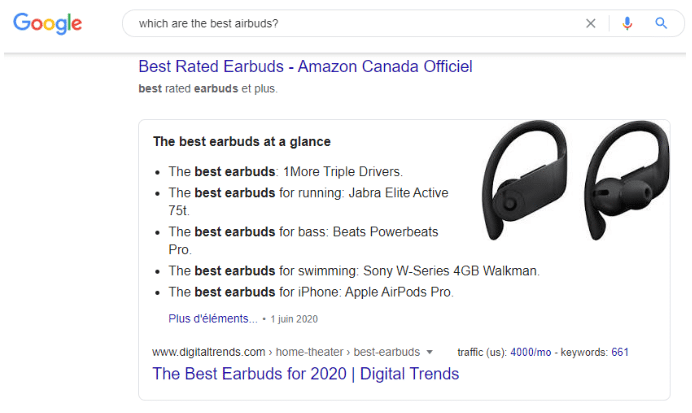Marketing Strategist Specialist
8 tips to make your brand content shine
Marketing Strategist Specialist
For years now, search engines have been in a state of constant evolution. You might even call them “response engines,” so proficient have they become at instantly responding to users’ questions. In 2018, Google published an article highlighting all the changes its search engine has gone through over the past 20 years. The goal? To explain how, over the years, access to information has become a real leitmotif.
For marketers, the goal behind the creation of brand content is to directly intercept their target users at the right time, without being intrusive or too over-the-top, but while unquestionably being more human.
If you want your content to resonate with your audience, it’s critical to know who that audience is. Once you’ve mastered your personas, you can start to ask yourself how your content can contribute to an optimal customer journey.
So, here are a few tips that will help you become a reference point in search results, create a bond of trust with your audience and grow your sales.
8 pieces of advice:
1. Create personalized content
2. Create multimedia content
3. Create intelligent content
4. Tell a story
5. Prioritize quality above all else
6. Structure your content
7. Draw up the entire user journey
8. Measure your efforts
1 - Create personalized content
Today, we no longer write just to talk about our brand, we write to respond to a clearly identified need. There are also new ways of doing things that allow us to communicate on a more individual level, which gives us the ability to address sometimes profoundly different customer journeys.
Here are a few new developments in search that are making hyper-personalization not only an asset, but an integral part of a good content strategy.
Featured snippets
Featured snippets are an excellent example of the shift towards hyper-personalization in marketing.
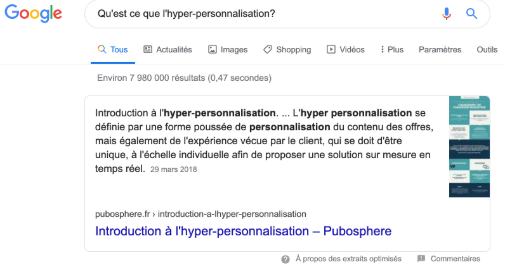
From an SEO perspective, this is a great demonstration of topical authority. Essentially, if Google thinks that YOU have a quality response to the question being asked, well, you’re lucky, and your content might appear as a star excerpt. The art of answering questions depends on strategic keyword research so you can exactly pinpoint users’ search intentions. Adviso has a very detailed article explaining how featured snippets work, and how they differ from rich snippets, generated by structured data inserted in a site’s code.
Let’s take a closer look at what these enriched results look like on Google today.
Photo carousel

Detailed schedule
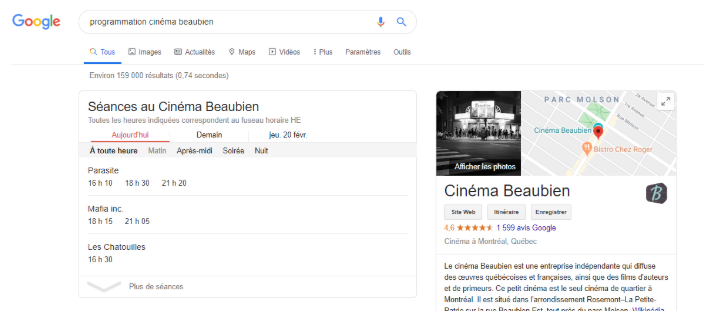
Recipe
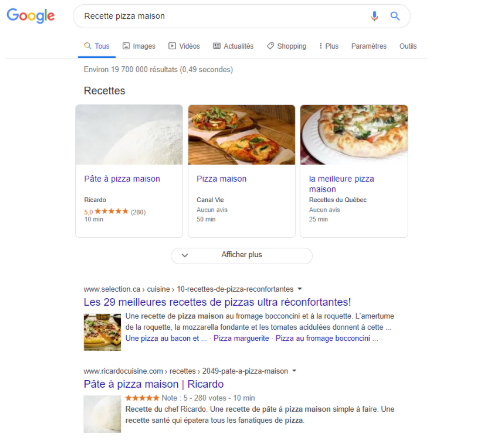
And it looks like this is only the beginning; we’re likely to see many more updates, always driven by real user needs.
Moreover, thanks to Google’s enriched search results, we’re seeing more and more functionality emerge in order to answer users’ questions in as few clicks as possible, even 0. It can be a sensitive point for any website hoping to generate more traffic, since hyper-personalized results can provide immediate satisfaction, with no need to dig further. This means site owners will have to learn to play with their content to make it sufficiently attractive to push users to “take a journey,” enjoy a pleasant experience, rather than be satisfied with a simple question and answer.
You can measure the impact of this type of initiative by closely monitoring your conversion rate and the increase in traffic that will have been generated.
Don’t forget that, while it’s important to be positioned in featured snippets and enriched results, it’s also critical that users’ experience on your site is positive enough to retain their attention and create a real bond of trust.
The FAQ section
There’s another option that will allow you to respond to users more exhaustively. Essentially, given the plethora of questions a user may have, it’s sometimes complicated to itemize all of them in a single blog post. If that’s the case, there’s a more direct solution, one that’s better adapted to some industries: building an FAQ section right into your site’s main navigation. This technique is far from new, but it tends to be too-often overlooked, since it only partially responds to the audience’s needs.
Let’s take the example of a site that’s governed by rules that don’t allow it to easily communicate through a blog and/or news section. The most effective way around that would be to build an FAQ section where you list the main categories of questions you might be asked about your products and services.
It’s also worth noting the weight that Google now gives this type of content. You have almost certainly noticed it — questions and answers appear directly in the results feed, putting your content front and centre. So why not use the opportunity to heighten your visibility and increase your traffic? The Google support site shows you how to integrate this functionality.
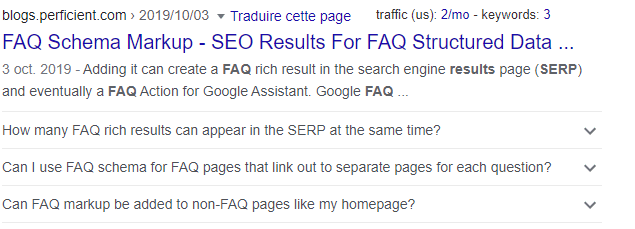
Voice search
Another element of hyper-personalization we should talk about is voice search. But what does that really mean? Google did a study on it in 2014, which revealed that young adults love using voice to search and that more than half of adolescents use voice search daily. For adults, the number was closer to 41%. A Gartner study conducted in 2016 predicted that by 2020, more than 30% of search sessions would be done vocally and more than 46% of users would be searching for local businesses daily. We’re still trying to ascertain how this really impacts a website’s conversions, but we cannot ignore the potentially positive effects of this functionality.
The question then is: How can you optimize your content so that it’s easily recognizable by Google in voice searches?
Here are the main principles your content should respect:
- Be as clear and concise as possible;
- Integrate structured data (“speakable” schema.org property);
- Respond to a search intention; respond to specific needs;
- Give an answer to a question;
- Personalize your content to be more human, more conversational, more natural.
Here’s a concrete example of what a voice search sent to a search engine would look like today:
“Hey Google, where can I buy a backpack?”
“Hey Google, how can I make my content a point of reference?”
If your content is well structured, it will contain a recap or summary that would allow it to instantly respond:
“Hi, here are some stores that sell backpacks near you”
“Hi, here are the broad steps to turn content into a reference point:
– Create personalized content
– Create multimedia content
– Create intelligent content
– Tell a story
– Prioritize quality above all else
– Structure your content
– Draw up the entire journey
– Measure your efforts”
By including this logic, you can also humanize your content, thereby ensuring that you are concretely responding to typical user questions. We generally recommend adding a brief explanatory introduction at the start of your article, because often that’s what’s picked up as the selected response in a voice search.
Define and know your audience
When we talk about audience, we are talking about a group of individuals. That means that you need to get to know these different target groups and the way they behave online, in order to meet their needs. It will help generate more traffic, and ultimately more sales.
At this point you are probably wondering what tools can help with this.
An audience is created through a close analysis of users’ search intentions in your industry. This means:
- An in-depth benchmarking of your industry;
- Research into the keywords generating traffic for your site;
- A clear definition of the different themes related to your audience;
- A clear definition of the main related search segments;
- Classification of users’ main search intentions.
Once you have a handle on your various existing audiences and the differences between them, you can then personalize your content based on their journey through your site. It will allow you to more easily suggest the product most likely to appeal to each of your audiences.
2 - Create multimedia content
We’ve been seeing it for a while now, multimedia content enriches our reading and creates a far superior experience in comparison with content created solely from text. The reader needs to have a good experience when they get to your page or your blog; we’re not just talking about having the answer to their question, but about creating a sense of wonder. Curious by nature, your reader must be encouraged to prolong their stay through the discovery of supporting material on a subject that interests them.
As a result, we are seeing the emergence of more and more content formats. There are many possibilities, and these now need to be included in your creative process.
Neil Patel enumerates six types of visual content you can easily use:
- Images
High resolution photos, either original or downloaded from sites like shutterstock, freepik or Flickr. But don’t forget to make sure you’re respecting the standards for SEO. - Videos
Webinars, animated videos, recorded videos integrated into your content - Infographics
Graphic designs, posters or banners - Memes and gifs
Easily create humorous visuals depicting particular moments or situations - Presentations
Technical or strategic supporting material published on sites like SlideShare - Personalized screenshots
Tools like Snagit allow you to capture and easily personalize screenshots, for example to create more relevant guidelines
Of all these different multimedia content formats, it’s video* that gets the most attention. In fact, the progression of traffic over the past few years has been significant, stimulating not only conversions, but also sales (an 80% higher chance of conversion, according to Insivia). What’s more, a Cisco study predicts that worldwide, web traffic driven by video will represent nearly 82% of consumer traffic by 2021.
It’s becoming essential to take an interest in and begin to adapt to this new trend, which is drawing in an ever larger number of users.
This can also be a huge help for indexing. You can ensure that your video respects the indexing basics by including strategic keywords for your topic and ensuring that your video generates quality backlinks.
For more information, check out this excellent article from Backlinko.
3 - Create intelligent content
Having evergreen content is becoming more and more important in order to stay visible and relevant in search. It’s referred to as evergreen content because it’s not time sensitive, it provides a response to a question on a particular topic that remains valid in spite of how the results evolve. It keeps its quality over time, and gives the site a strong position with no risk of brutal changes or variations. This makes it long-lasting, even “permanent” content.
Let’s look at an example:
The subject “how to make good kids’ lunches” is rich content that can easily be reused over the years. In this Hubspot article dedicated to evergreen content, you’ll find five easy ideas for creating evergreen content.
We are also going to talk about the emergence of intelligent content. This means that it’s absolutely acceptable to reuse a topic like this in different formats, as we saw in more detail above, to complement our “evergreen” subject and give users more ways to consume our content. For example, a must-do list for a successful back-to-school, a checklist to prepare for school enrollment, a preparatory video, etc.
That way your content will be evergreen, dynamic, adaptable, recyclable and multichannel.
4 - Tell a story
In content, storytelling is an excellent way to get close to your readers and provide them with something far more powerful than a simple explanation of a concept. Hubspot provides an excellent definition of storytelling, calling it a process of using fact and narrative to communicate something to your audience. Some stories are factual, and some are embellished or improvised in order to better explain the core message.
To do this, you’ll need a certain amount of expertise in the writing process, but it’s more than that. You have to invite the reader on a “journey” rather than provide a simple contextual response. The journey needs to be created in part by the passionate, intriguing story you tell, and in part by the fact that you’ve exactly responded to the reader’s question if you want to create that feeling of deep satisfaction when they’re done reading.
Today, many techniques exist to routinely include this process in your content. We would highly recommend watching this excellent TED talk from Josh Campbell on the subject. Give your users a reason to appreciate your brand in a new, deeper and more meaningful way.
They will respond by being more receptive when you offer up a product or service.
5 - Prioritize quality above all else
When you think about quality content, what comes to mind? Of course, it’s important to write copy that captivates your audience and answers their questions, but there’s more to it than that. Quality is subject to a collection of factors determined by web spiders, grouped under the term E.A.T.: Expertise, Authoritativeness, Trustworthiness.
On December 5, 2019, Google published their new guidelines, highlighting important ideas that every content creator should henceforth be taking into account.
But how can you make sure your content meets these new guidelines?
Here’s a summary of the three most important changes to retain:
1. Ensure that the writer has credibility in their field
Who is writing your content? Is this person an expert? Or are they an intermediary approaching the topic with little knowledge or experience?
2. Ensure that you’re totally transparent about the source of your information
Have you correctly cited the author of your work, your sources and references, and have you provided your contact or about page?
3. Gain authority in your field of activity
- Do you have partner sites that talk about you?
- Are you cited by trusted sites?
- Do you have testimonials from current clients that you could share?
Create a quality network to boost your visibility. Commit to a link-building strategy to increase your number of backlinks. The important thing is to get people talking about you, and saying good things!
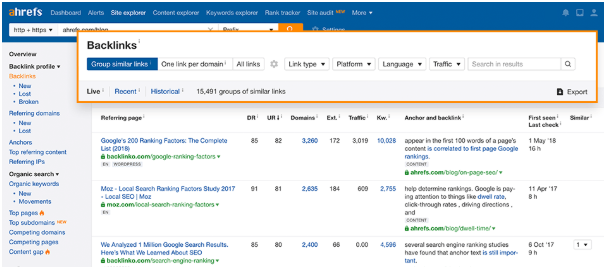
Example of an article containing author information:

(Source: Moz)
6 - Structure your content (SEO)
Do you find yourself wondering what structure might work best for your content?
Think about SEO first. SEO is essentially the practice of respecting Google’s fundamental rules to ensure faultless indexing. The structure of your content can be compared to the foundation of your house. If you don’t have a good foundation, it won’t be long before your house starts to collapse in on itself. Ok that’s a bit extreme, but that’s kind of what Google is looking for when its spiders crawl your content. It needs to respect the basic standards for good architecture to be easily recognizable and readable.
Good SEO architecture focuses on five main elements:
- Meta tags (meta-title, meta-description, hn tags)
- Internal links (internal links that direct readers to other, complementary content)
- References (supporting your content with trusted sources)
- Complementary formats (videos and images to enhance your text)
- A call to action (a bonus for the reader and a way to thank them for having read your content!)
These basic principles can be followed consistently and should become essential guidelines anytime you’re creating new content. You’ll increase your organic traffic and, once again, increase your likelihood of converting your users.
7- Draw up the entire user journey
The major content marketing challenge we’ll be facing in 2020 will be providing the content users need, regardless of where they are in their journey, whether or not they are familiar with your brand. Here’s what this means, more concretely:

(Source: HubSpot)
A user journey goes from the discovery stage to the purchase decision stage. It’s a methodology similar to the methodology for inbound marketing.
The principle is simple: it involves putting the emphasis on understanding your users’ actual journey through your content, so you can understand what the optimal experience would be, from discovery to conversion. That means that once these different stages have been identified, you should be creating content that covers each stage of the journey.
So:
- Content for stage 1: Guides, presentations…
- Content for stage 2: Comparisons, webinars, interviews, FAQ…
- Content for stage 3: Checklists, white papers, trials…
You’ll then need to make sure that the themes you choose properly cover the full range of search intentions formulated by your various audiences.
Of course, that requires an in-depth study of your field, the existing competition in your area of activity as well as the creativity to find a way to differentiate yourself. This will guide not only the way you create your content, but also your different marketing campaigns. If you’re interested in learning more on the subject, check out this excellent article by Catherine Gratton-Gagné.
8 - Measure your efforts
So, you’ve committed to a content strategy that aims to respect the major principles that would allow it to become reference content, but now you’re not sure what repercussions this is having on your business and your sales.
It’s time to start measuring! Collect user data regularly to understand their behaviour and interactions with your content. A dashboard like the one offered by Google Data Studio that brings together your main data segments could be particularly helpful.
Key performance indicators for content marketing will allow you to measure your success. Here are a few that you can add to your list:
- Increase in number of readers
- Average session length
- Unique page views
- Number of new sessions
- Bounce rate
You may also want to learn more about your audience, for example their demographic or sociological profiles, and adjust your activities depending on what you find out.
It will make it easier for you to keep an informed eye on the results of your efforts, and to understand how much of your ROI you should attribute to the activity.
Content marketing has become essential for creating lasting relationships with your target audience. The investment required is minimal compared to the potential gains for your company: visibility, trust, credibility and of course, an increase in sales. In addition, if your content captures your readers and is adapted to their needs, you’ll earn their loyalty over the long term and become a point of reference in your industry!
